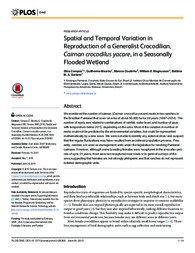Spatial and temporal variation in reproduction of a generalist crocodilian, Caiman crocodilus yacare, in a seasonally flooded wetland.
Spatial and temporal variation in reproduction of a generalist crocodilian, Caiman crocodilus yacare, in a seasonally flooded wetland.
Autoria: CAMPOS, Z.; MOURAO, G.; COUTINHO, M.; MAGNUSSON, W. E.; SORIANO, B. M. A.
Resumo: We monitored the number of caiman (Caiman crocodilus yacare) nests in two ranches in the Brazilian Pantanal that cover an area of about 50.000 ha for 28 years (1987?2014). The number of nests was related to combinations of rainfall, water level, and number of days with temperature below 20°C, depending on the area. Most of the variation in number of nests could not be predicted by the environmental variables, but could be represented mathematically by a sine wave. We were not able to identify any external driver and suspect that the regular fluctuations may have resulted from an intrinsic population process. Presently, ranches are used as management units under the legislation for ranching Pantanal caimans. However, although some breeding females were recaptured in the area after periods of up to 21 years, most were not recaptured near nests or in general surveys of the area, suggesting that females are not strongly philopatric and that ranches do not represent isolated demographic units.
Ano de publicação: 2015
Tipo de publicação: Artigo de periódico
Unidade: Embrapa Pantanal
Palavras-chave: Crocodilians
Observações
1 - Por padrão são exibidas publicações dos últimos 20 anos. Para encontrar publicações mais antigas, configure o filtro ano de publicação, colocando o ano a partir do qual você deseja encontrar publicações. O filtro está na coluna da esquerda na busca acima.
2 - Para ler algumas publicações da Embrapa (apenas as que estão em formato ePub), é necessário ter, no celular ou computador, um desses softwares gratuitos. Sistemas Android: Google Play Livros; IOS: iBooks; Windows e Linux: software Calibre.
Acesse outras publicações
Acesse a Base de Dados da Pesquisa Agropecuária (BDPA) para consultar o acervo completo das bibliotecas da Embrapa.

